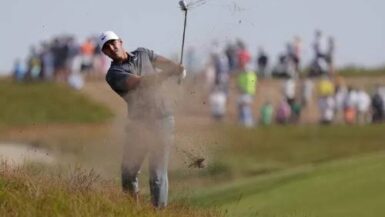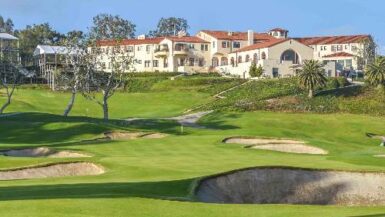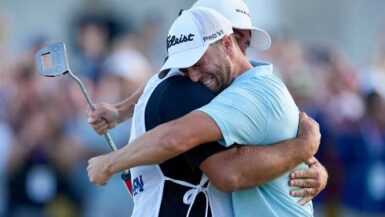At the 2005, 2006, and 2007 U.S. Opens, the chaotic twists and turns of the greens at Pinehurst, Winged Foot and Oakmont were Tiger Woods’s undoing. “I had plenty of 8-10 foot putts, but they had three feet of break. You’re not going to make those all the time” he said after his final putt at Oakmont veered away, sealing his defeat. At Southern Hills’s PGA Championship, a mere two months later, Woods played to the flat places on the greens, where he had straight-in putts. “I rolled in the straighter putts even though they were a bit longer” he remarked after hoisting his fourth Wanamaker Trophy.
Cut to last week and, same as always, there is someone declaring the latest U.S. Open venue, the “toughest ever.” This time it was friendly Phil Mickelson, doing his best to throw the U.S.G.A. a bone and steer “the buzz” in a media-friendly direction. Predictably, just like with Michelle Wie and with Tiger claiming the Grand Slam was reasonably attainable, everyone scrambled like rabbits to relay the benediction, not caring whether it might actually be wrong, since it’s such good copy.
No matter what Phil Mickelson, USGA set-up chair Mike Davis, or any nasal tenor in the broadcast booth may stridently tell you, having Torrey Pines for a U.S. Open venue is déjà vu all over again. Taller rough and faster greens aside, at the end of the day, Torrey is still Torrey. There’s a new tee here or there from Rees Jones, but as ESPN’s Scott Van Pelt discussed with Andy North, “it’s got flat lies in the fairway and flat greens,” and the same holes as it had this February and every other February. While it may have a longer fang or talon here, Torrey’s flat greens means lower scores. More guys will make more straight putts.
Normally, one of the draws of the U.S. Open is the venue itself. As I like to say, “during U.S. Open week, the golf course is the star.” Shinnecock, Merion, Oakmont, Winged Foot, Baltusrol: these mighty, iconic courses are seen once a decade, and with their unique twists and turns architecturally, consistently prove to be the toughest golf puzzles a pro can tackle in his entire career. This year, for the first time since the plain yogurt Olympia Fields, the golf course will not be the star. We see Torrey all the time. There is no romantic notion of mystery, no mythic feeling of a course rematerializing out of the mysts of time to torment the greatest heroes of the game before returning to sacred Olympus to await a re-emergence. Instead, Torrey, through this familiarity and through its flat nature, proves a rather pedestrian choice as a U.S. Open golf course: a collection of average holes, but the prettiest fountain in U.S. Open history.
Still, there were plenty of good reasons to choose Torrey and despite the course’s already minimal strategy, there is plenty to look forward to this week. Ironically, the flat greens, familiarity, and lack of strategy may mean more birdies, more excitement and more roars from the gallery. The “restrictor plate” the U.S.G.A. puts on a golf course is lessened this year, so this will be the true test of how good Mike Davis is at set-up and whether he will avoid the mistakes of Tom Meeks.
The rough and greens at Oakmont and Winged Foot are the toughest in the world. You’re naturally going to have higher U.S. Open scores there. Torrey is not in the same category of difficulty; there is no excuse for a +5 winning score here. But Mike Davis is sharp. He’s run excellent Opens at both Winged Foot and Oakmont. He’s much better at identifying +5 than Tom Meeks ever was because he does it with much less outcry. He also knows +5 at Torrey would be viewed as a more manufactured result than a +5 at Oakmont. He’ll want to avoid making the tournament about himself. He also knows that lower scores will mean that the fans will get more bang for their buck. Instead of the normal pained groans as a putt veers aside, then polite golf claps for the tap-in par, we’ll get roars for birdies.
The fans – there’s another reason for the choice of Torrey. The success in marketing Bethpage as “The People’s Open” created a dilemma for the U.S.G.A.: now everybody wanted one.
The choice of public courses as major championship venues should have been a no-brainer long ago. Golf’s soul is an egalitarian one. Golf’s greatest virtue is that anyone – from 3 to 103, from peasant to president, from Denver to Durban, Oslo to Buenos Aires – anyone can play. For years, the U.S.G.A. took scathing criticism for being elitist – not just in choosing Open venues, but in many other policies – but recently I made two personal observations.
First, they learn from their mistakes. They actually listened to criticism and changed policies and direction in an effort to improve not only themselves, but the game in general. Second, good men like Rand Jarris, Craig Smith, and Chris Wightman lead a solid core of leaders within the U.S.G.A. that take the good of the game as their first goal, not merely as a shield behind which to merely claim a right to a lilywhite reputation by association.
In choosing Torrey, the U.S.G.A. put aside pride and image and made an altruistic, pragmatic decision. The west coast needed a “bookend” public Open venue as a rejoinder to Bethpage. Torrey is gorgeous, has room for all the fans and fanfare, and is public. Additionally, it will get everyone excited for Pebble in 2010 and Olympic Club in 2012, the next two California U.S. Opens.
It’s been a tough road to get here, though. Where Bethpage was universally embraced by New Yorkers, the model didn’t translate as smoothly here, mostly because Rees’s “Rees-storation” made the locals’ beloved muni a much more difficult slog. Californians are not New Yorkers and while New Yorkers embrace how hard Bethpage is, Californians people want a fun, low impact round. Being on high alert to a triple bogey on every shot is not their idea of a good time. They have every right to gripe when $3.5 million was poured into a course they love like the child of their loins – and that they love as much as NYCers love Bethpage – only to find out that, when they think they’ve sent their daughter to finishing school, she’s come back with tattoos and a nose ring.
Now to be fair to Rees, before he got to Bethpage, it was a shipwreck: stones in every bunker, seaweed clinging to her hull, her greens mis-shapen, her sails torn and tattered, her fairways jungles, and her masts shattered. After Rees got through, New York City had a galleon in full sail.
To the contrary, before Rees got to Torrey, she was already a well-equipped frigate: sleek, weatherly, and fast. What did the city get for $3.5 million? Not a much better golf course, but a much tougher one for muni players. Rees may have become a victim of the increased expectations that come with the title of “Open Doctor” and finally hit the chamber with the bullet in it.
Built by Billy Bell and son in 1957, Torrey is gorgeous, with holes clinging to clifftops overlooking the Pacific, but as one famous architecture critic wrote, “a fairly dull layout with a view…3,6,7 of the north are the only [holes] bringing the ocean or ravines into play and they take a much more exciting picture than they play.”
Some critics say the ravines were not used to maximize strategic angles, others say the bunkering is mundane – five o’clock, seven o’clock, lather, rinse, repeat – others say there’s no risk reward golf, but Jones did improve some holes. Fourteen and sixteen have the best changes as they embrace the canyon, one hugging it tightly, the other requiring a diagonal tee shot over it. Additionally, the false front green at thirteen is so severe, careless players are pitching from exactly the same place from which they hit their last shot.
Nevertheless, Billy Bell didn’t build greens like Alister MacKenzie or C.B. Macdonald. Further, all Rees did was install some ridges to segment the large greens into three small ones, but the tour pros won’t have any problem hitting the right section and even if they do, they can two-putt from 40 feet without as many histrionics as mere mortals require.
Lastly, one of the biggest issues this year will be the famous spongy but clingy kikuyu rough. It’s more famous at Riviera, and rightfully so, the kikuyu at Riviera is slightly different from the kikuyu at Torrey Pines. According to one U.S.G.A. official who has the “kikuyu double” on his resume – he officiated at both courses – the kikuyu at Torrey is a different strain and was mostly one-and-a-half to two inches deep, with some patches reaching three inches. That’s difficult, but not unfair. The kikuyu at Riviera is four to five inches deep. “The kikuyu just took away the skill of the players at that tournament.”
In an effort to control the kikuyu, tournament director Mike Davis ordered the greenside roughs over seeded with a blend of rye and kikuyu. The debate still rages over whether this will be effective. Some pundits believe the rye will prevail over the kikuyu and slow down the kikuyu’s growth. Others believe the kikuyu will hold sway over the rye since it is a warm season grass and the rye is a cool season grass. It gets hot in Palm Springs – 85 in April – and by high summer, it will exceed ninety. Again, the success or failure of this decision will be more telling as to Mike Davis’s skill in tournament set-up than the always severe conditions of Oakmont and Winged Foot.
So there it is: at Oakmont you have eighteen flat lies, one on every tee box, but at Torrey, you have the flattest greens in the last twenty years of U.S. Opens, which means almost every flag will be a green-light flag for Tiger Woods. He won’t have to “play to a spot” and hope it filters to the pin. The pin point precision of the past three years is absent. He owns this place, winning a staggering number of tournaments here. Knee rehab or no knee rehab, he’s a prohibitive favorite to end the “Southern Hemisphere streak” of four consecutive winners from below the Equator. In fact, Tiger may take three in a row since he already won at Bethpage and he owns Pebble Beach.
Still, it’s southern California, where the air is like wine, the days break clear and glorious, and the sun beams jubilantly. A scent of pine wafts over the course and television gets to broadcast four of those days you see advertised in breakfast cereal commercials where a sickeningly chirpy, overly-pretty family bounces around like cheery kangaroos while flakes of corrugated cardboard shower into a bowl, and where Dan Hicks nasally drones on for hours about Tiger like a deery-eyed gazelle. Royal Birkdale can’t get here fast enough.




